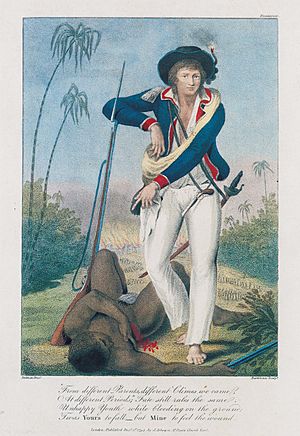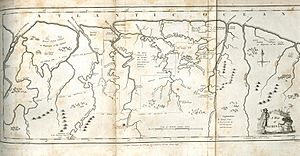John Gabriel Stedman facts for kids
Quick facts for kids
John Gabriel Stedman
|
|
|---|---|

John Gabriel Stedman stands over a slave after the capture of Gado Saby, a village of Maroons in Surinam, from the frontispiece of his Narrative
|
|
| Born | 1744 Dendermonde, Austrian Netherlands |
| Died | 7 March 1797 (aged 52–53) Tiverton, Devon |
| Occupation | Military officer, author |
| Nationality | Dutch / Scottish |
| Period | 1790s |
| Genre | Autobiography adventure |
| Notable works | The Narrative of a Five Years Expedition against the Revolted Negroes of Surinam |
| Spouse | Adriana Wiertz van Coehorn, Joanna |
| Children | Sophia Charlotte, Maria Joanna, George William, Adrian, and John Cambridge |
| Military career | |
| Allegiance | Dutch Republic |
| Service/ |
Army |
| Years of service | 1760–1778 |
| Rank | Captain |
| Unit | Scots Brigade |
John Gabriel Stedman (1744 – 7 March 1797) was a soldier and writer from Scotland, born in the Netherlands. He is most famous for his book, The Narrative of a Five Years Expedition against the Revolted Negroes of Surinam, published in 1796.
This book shares his experiences in Suriname from 1773 to 1777. During this time, he was a soldier helping local troops fight against groups of Maroons, who were formerly enslaved people who had escaped. Stedman first wrote about his adventures in a personal diary. Later, he used this diary to create his famous Narrative. The book became very popular and helped the growing movement to end slavery. It showed people what slavery and colonialism were really like.
Contents
Early Life and Family
John Gabriel Stedman was born in 1744 in Dendermonde, a town that was then part of the Austrian Netherlands. His father, Robert Stedman, was a Scottish officer in the Dutch Republic's Scots Brigade. His mother, Antoinetta Christina van Ceulen, was French and Dutch.
John spent most of his childhood in the Dutch Republic with his parents. He also visited his uncle in Scotland. Stedman once said his childhood was "chock-full of misadventures and abrasive encounters of every description."
Military Adventures
Stedman started his military career when he was 16 years old. His first rank was ensign, where he helped defend outposts in the Low Countries for the Stadtholder (a leader in the Dutch Republic). He later became a lieutenant. In 1771, Stedman joined the army again because he had a lot of debt after his father passed away.
Journey to Surinam
On December 24, 1772, Stedman left the Dutch Republic. He had volunteered to serve in the West Indies. He was given the rank of Captain, which was a temporary and honorary title. His group had 800 volunteers. They were sent to Suriname on a ship called the Zeelust. Their mission was to help local troops fight against groups of escaped enslaved people, known as Maroons, in the eastern part of the colony.
The soldiers were trained for battles in Europe. However, they were not ready for the guerrilla fighting style of their opponents in Suriname.
Challenges with Leadership
When they arrived in Suriname, Stedman received orders from Colonel Fourgeoud, the commander of the new troops. Colonel Fourgeoud was known for eating fancy meals and drinking wine while his soldiers had very little food, and it was often spoiled. He treated Stedman badly, giving him pointless tasks and taking away his ammunition. Stedman felt that Fourgeoud was a poor leader who did not care about his troops. He believed Fourgeoud kept his position by bribing people. Stedman wrote, "I solemnly declare to have still omitted many other calamities that we suffered" because of Fourgeoud's bad leadership.
In 1775, Stedman got sick in Suriname. He wrote to Colonel Fourgeoud, asking for time off to get better and for six months of military pay that he was owed. Fourgeoud refused his request twice, even though he allowed other officers to take time off. Stedman later wrote that this made him so angry he wished them both in "Hell."
Fighting Alongside the Free Negro Corps
Besides the 800 European soldiers, Stedman also fought with a new group called the Free Negro Corps (FNC). These were Black enslaved people who had been bought from their enslavers. They were promised their freedom, a house with a garden, and combat pay if they fought against the Maroons. The FNC started with 116 men. Later, 190 more were bought and added to the group because the first group showed great bravery.
Campaigns and Battles
Stedman served in seven campaigns in the forests of Suriname. Each campaign lasted about three months. He only fought in one major battle, which happened in 1774. This battle ended with the capture of a village called Gado Saby. The front cover of Stedman's Narrative shows a picture of this battle. It shows Stedman standing over a dead enslaved person, with a village burning in the distance.
During these campaigns, ambushes were common, and diseases spread quickly. This led to a huge loss of soldiers. So many soldiers died that 830 more European troops were sent from the Dutch Republic in 1775 to replace the original 800. The campaigns were full of sickness, anger, tiredness, and death. Stedman saw the terrible things that happened in battle. He observed how both sides played a "cat-and-mouse" game, which just pushed the fighting across Suriname instead of stopping it.
Life in Surinam
Surinam was first settled by the governor of Barbados in the 1650s. The Dutch soon took control and quickly started growing sugar on large farms called plantations. By 1683, Surinam was controlled by the Dutch West India Company. The colony's economy relied heavily on the forced labor of enslaved people from Africa.
Two large rivers were very important to the colony: the Orinoco and the Amazon. When Stedman was there, the Portuguese lived along the Amazon River, and the Spanish lived along the Orinoco River. Dutch settlers were spread along the coast, and the French lived in a small settlement called Cayenne.
Stedman's Famous Book: The Narrative
The Narrative of a Five Years Expedition against the Revolted Negroes of Surinam is a book about John Gabriel Stedman's own experiences in Suriname from 1773 to 1777. Stedman kept a diary during his time in Suriname. However, he wrote the Narrative manuscript ten years after he returned to Europe.
In his book, Stedman describes the beautiful landscapes of Suriname in great detail. He pays close attention to the plants, animals, and the daily lives of the native people, free and enslaved Africans, and European settlers in Suriname. He observed the different cultures living there at the time: Dutch, Scottish, native, African, Spanish, Portuguese, and French. Stedman also describes what daily life was like in the colony.
The first pages of the Narrative talk about Stedman's journey to Suriname. He spent his days reading on the deck of his ship, the Boreas, trying to avoid those who were seasick. The Boreas traveled with another ship, the Weftellingwerf, and three new transport ships. Stedman first arrived in Suriname on February 2, 1773.
When he arrived, Stedman and his troops were met by people from Fortress Amsterdam, located along the Surinam River. Here, Stedman gives his first description of Suriname's landscape. He wrote that the land was full of wonderful smells, like lemon, orange, and shaddocks.
Parts of the Narrative continue to describe Suriname's natural environments. Stedman writes that some parts of Suriname are mountainous, dry, and barren. But much of the land is rich and fertile, with a growing season that lasts all year, thanks to rains and a warm climate. He notes that in some areas, the land is low and marshy. Crops are grown using a "flooding" method of irrigation, similar to what was used in ancient Egypt. Stedman also describes Suriname as having large areas that are not farmed. There are huge forests, mountains (some with valuable minerals), deep marshes, swamps, and even large savanna areas. Some parts of the coast are hard to reach because of rocks, riverbanks, quicksand, and bogs.
In his Narrative, Stedman writes about the strong contrast between the beauty of the colony and the violence and cruelty he first saw there. He tells several stories about the terrible conditions enslaved people lived in and the horrors they faced.
Stedman's Views on Slavery
Stedman's feelings about enslaved people and slavery are a topic of discussion among scholars. Even though his book helped the movement to end slavery, Stedman himself was not completely against it. His book sometimes defends slavery, saying that suddenly freeing everyone would cause problems. Stedman even believed that slavery was needed in some way for European countries to keep enjoying goods like tobacco and sugar.
Stedman's relationship with an enslaved woman named Joanna makes his views on slavery even more complex. Stedman described their relationship as "romantic love," but Joanna's feelings about it are not known.
His book also shows a viewpoint that favors his own culture. Some critics say the book made Stedman seem more in favor of slavery than he actually was. But Stedman's feelings for individual enslaved people were different from his views on slavery as a system. He often showed sympathy for the suffering of enslaved people in his book. However, this sympathy was often hidden by his opinions about slavery as a whole, which were very complex.
Later Life and Passing
Not much is known about Stedman's last years. He was promoted to major in 1793 and then to lieutenant-colonel in 1796. The title page of his book says he reached the rank of captain, which was the honorary rank he received when he went to the West Indies.
Family stories say that Stedman had a serious accident around 1796. This prevented him from leading a regiment in Gibraltar. He then moved to Tiverton, Devon. Before he died, Stedman asked to be buried in the parish of Bickleigh, next to a famous gypsy king named Bampfylde Moore Carew. He specifically asked to be buried at midnight by torchlight. However, his final wish was not fully granted, as his grave is in front of the church's vestry door, on the opposite side from Carew's grave.


